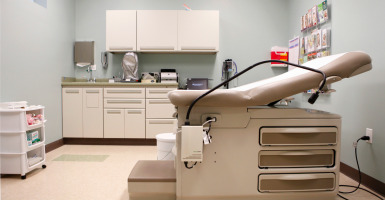In a victory for women’s health and safety, the 5th Circuit Court of Appeals on Tuesday upheld a number of the provisions of a 2013 Texas law that include common sense regulations of abortion clinics and abortion doctors.
Known as H.B. 2, the Texas law requires, among other things, that abortion clinics meet the same regulations for cleanliness and safety as other outpatient surgical facilities and that doctors working in those clinics have admitting privileges at nearby hospitals. These provisions help to ensure that women are not subject to substandard conditions or practices that could jeopardize their health and even lives.
Regulations like H.B. 2 are common sense and much-needed policy measures. The dangerous, unsanitary conditions of Philadelphia abortionist Kermit Gosnell’s “house of horrors” shocked the nation when they came to light during his 2013 murder trial. But Gosnell’s clinic—though one of the more horrific—is not an outlier in the abortion industry.
Dozens of other abortion clinics across the country have faced investigations, complaints, and criminal charges. Many continue their dangerous and life-ending work with little to no oversight or inspection.
While it claims to advocate for women, the abortion industry is often the one fighting reasonable laws to ensure their patients’ health and safety. In Texas, Planned Parenthood and a number of other abortion clinics that are unable to upgrade their facilities or employ doctors with admitting privileges, have challenged parts of H.B. 2. They argue the law is unconstitutional because it will result in the closure of a number of abortion facilities, placing a serious burden on the right to abortion.
As the 5th Circuit noted this week, however, even as the Supreme Court invented a constitutional right to abortion in 1973 in Roe v. Wade, the justices were clear that the decision doesn’t preclude states from placing reasonable requirements on abortion clinics and doctors. Specifically, the Supreme Court found:
The State has a legitimate interest in seeing to it that abortion, like any other medical procedure, is performed under circumstances that insure maximum safety for the patient. This interest obviously extends at least to the performing physician and his staff, to the facilities involved, to the availability of after-care, and to adequate provision for any complication or emergency that might arise.
Since the Roe decision, the Supreme Court has further defined the contours of the right to abortion and what states can do to regulate the abortion industry. In Planned Parenthood of Southeastern Pennsylvania v. Casey, the Supreme Court determined that states may not impose an “undue burden” with the “purpose or effect of placing a substantial burden in the path of a woman seeking an abortion … .” The Supreme Court clarified in Gonzales v. Carhart that laws regulating abortion must pass rational basis review—the lowest standard of review—which requires that a particular regulation be rationally related to a legitimate state interest.
In upholding the abortion clinic regulations, the 5th Circuit panel concluded that H.B. 2 met those legal standards: “Texas’ stated purpose for enacting H.B. 2 was to provide the highest quality of care to women seeking abortions and to protect the health and welfare of women seeking abortions. There is no question that this is a legitimate purpose that supports regulating physicians and the facilities in which they perform abortions.” Further, the district court erred by “substituting its own judgment for that of the legislature,” on whether H.B. 2 advances the state’s interests in maternal health and increased quality of care.
The 5th Circuit’s decision this week means that H.B. 2’s common sense protections can now be applied throughout Texas, with the exception of one abortion facility in McAllen and one doctor who often performs abortion procedures there. Last year, a different panel of the 5th Circuit also upheld the admitting privileges requirement, as well as a restriction on the use of dangerous abortion-inducing drugs like RU-486.
When the Supreme Court created a right to abortion in 1973, it took the issue out of the hands of the American people, preventing citizens and legislatures from making reasoned policy and fully weighing the impact of abortion on the lives of women and unborn children. The result? U.S. abortion policy is extreme among developed nations in allowing elective, late-term abortions and a lucrative, yet largely unaccountable, abortion industry daily endangers the lives and health of women.
Those challenging the Texas law have vowed to appeal the case to the Supreme Court. Meanwhile, the justices are currently considering whether to review another case involving a similar admitting privileges requirement in Mississippi.
With similar cases in Arizona and Wisconsin making their way through the courts, it’s possible the Supreme Court may weigh in on these issues in the near future. Whether through these cases or others, the court would do well to reconsider the long, deadly shadow its abortion decisions have cast over law, medicine, and society.

























